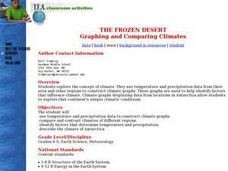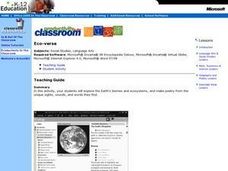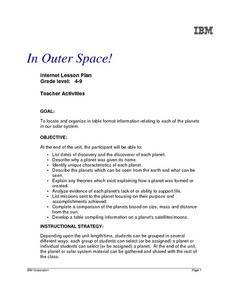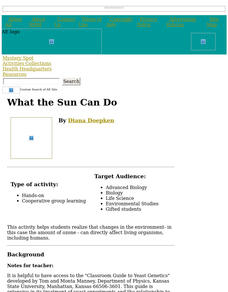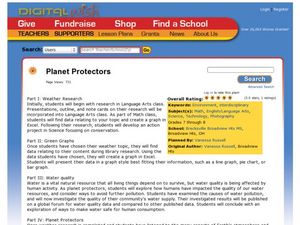Curated OER
The Frozen Desert: Graphing and Comparing Climates
Students explore the concept of climate. They use temperature and precipitation data from their area and other regions to construct climate graphs. These graphs are used to help identify factors that influence climate.
Curated OER
The Spectrum of a Star
Tenth graders identify stars based on their line spectra. In this astronomy lesson, 10th graders analyze spectrograph and determine the elements present in the star. They explain the relationship between temperature and star classes.
Curated OER
Across the Landscape
Learners create a unique, stunning display of the Earth's landforms. They discuss the many different types of the Earth's landforms such as deserts, mountains, oceans, plateaus, coastlines, and marshlands. Students discuss what...
Curated OER
The Land of Pebbles
Students, after researching and comparing a variety of ecosystems and environments on the earth, create a unique landscape scene of an imaginary environment depicting pebbles. They then write about their imagined environment and its...
Curated OER
WHAT HOLDS US TO EARTH?
Students they imagine they are Galileo and try to duplicate Galileo's experiments and results.
Curated OER
Mission Planning: Earth/Mars Comparisons
Students compare and contrast conditions on Mars to those on our own planet, specifically, their local or regional environments. The physical characteristics, the atmosphere, and other astronomical data is considered.
Curated OER
Antarctica
Students explore why Antarctica is so important to the planet. They investigate the physical characteristics. Students create their own unique treaty of governance for Antarctica and discuss how laws are enforced in Antarctica.
Curated OER
Continents and Oceans on the Move
Young scholars create an awareness of the vast percentage of water covering the earth. They relate similarities/differences between topographical maps and other maps of various time periods. Students examine how to use a topographical map.
Curated OER
From the Gulf of Mexico to the Moons of Jupiter
Students compare deep ocean conditions to those found on the moons of Jupiter. In this Earth science instructional activity, students consider the possibilities and conditions needed to support simple life. Students examine the habitats...
Curated OER
Biosphere Socratic Questions
Students examine the origin of life on Earth and its evolution through geologic time by participating in a whole class discussion. They respond to prompts that lead them to conclusions about the interactions among the biosphere and the...
Curated OER
Cave Painting
Sixth graders create replica cave paintings using flowing lines, texture, and earth colors.
Curated OER
Eco-Poetry
Students explore the Earth's various biomes and ecosystems using Internet research. They create a multimedia poem using the photos, sounds, and vocabulary from their research.
Curated OER
The Planets in Our Solar System
Students gain knowledge about earth and space science by studying the nine planets in the solar system as well as their key characteristics. In this solar system instructional activity, students identify the nine planets. Students work...
Curated OER
Geography and Its Five Themes
Geography is not limited to just learning about the Earth and its physical features.
Curated OER
The Mathematical Fingerprint of Our Solar System
Young scholars study the beautiful mathematical model unique to our solar system.
Curated OER
Million Dollar Machine
Students explore their self-awareness. They discuss the words unique, extraordinary and irreplaceable and their strengths and weaknesses. They write five things their bodies or Million Dollar Machines can do and investigate their blood...
Curated OER
Are Nanobacteria Alive: Sample Socratic Questions
Students comprehend the definition and uniqueness of life and its complexities. They examine what characteristics constitute a living organism. Students recognize the extent of the role nanobacteria play in the movement and molding of...
Curated OER
Fall and Winter Religious Celebrations
Students discover the unique beliefs and celebrations of the five major religions in the world. In groups, they discuss the terms associated with each religion and are read books about their celebrations. They create their own dharma...
Curated OER
Connecting to the Poles through TEA E-Mail
Students explore the integral role of the remote polar regions within the global system. They answer the question: How will change in the ice sheets impact global sea level and climate? Students comprehend that the poles offer unique...
Curated OER
Landforms
Students research landforms created by tectonic movement. In this landforms lessons, students discuss caves, canyons, mountains, valleys, and undersea vents and the ecosystems unique to these environments.
Curated OER
In Outer Space
Students use the internet to gather information on the solar system. They identify the discoverer and unique characteristics of each planet. They compare and contrast each planet based on size, mass, and distance from the sun. They...
Curated OER
What the Sun Can Do
Students develop and test a unique, personally-relevant hypothesis about the consequences of exposure to UV radiation based units on a living organism, common baker's yeast (Saccharomyces cerevisiae).
Curated OER
The History of Life
In this origin of life worksheet, students will review the different theories on how life originated on the Earth including the experiments conducted by Louis Pastuer, Francesco Redi, and Miller and Urey. Students will complete 14 fill...
Curated OER
Planet Protectors
Students explore ways to protect the earth. In this environmental issues and technology lesson, students investigate the water quality in their community and compare their findings to the water quality in other geographic...
